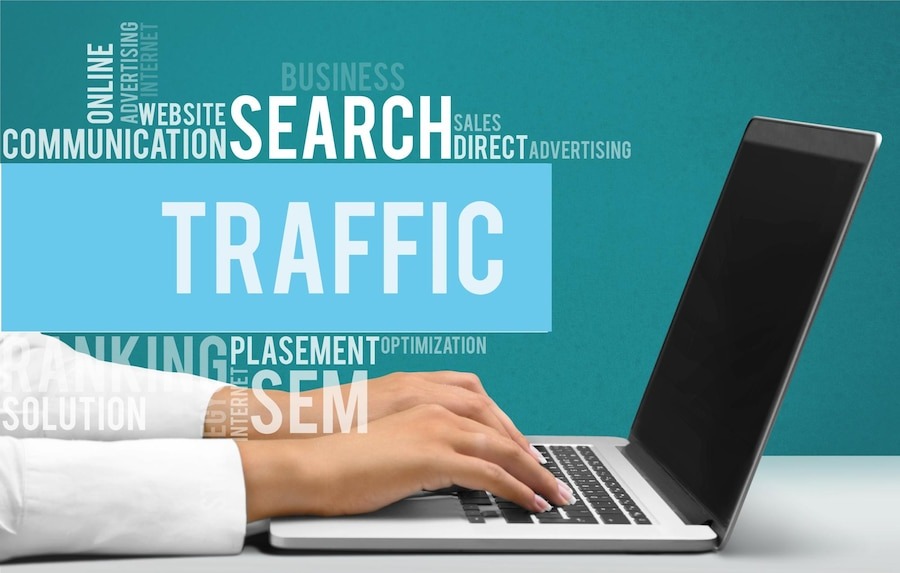What is Website Traffic? Tips to Boost Website Traffic
Summer Nguyen | 05-18-2023

In today’s digital age, website traffic is the heartbeat of online businesses. With 5.45 billion internet users globally in 2023, representing 67.1% of the world population, having a strong online presence is more critical than ever. Businesses across industries are increasingly focusing on driving traffic, especially since 68% of all online experiences start with a search engine, highlighting the importance of website visibility.
Whether you run a blog, an e-commerce site, or a corporate page, the number of visitors you attract defines your success. But what exactly is website traffic? Why is it crucial? More importantly, how can you effectively optimize it? Let’s explore all of this information in this blog post.
What is Website Traffic?

Website traffic can be defined as the number of visitors to a website. When a visitor spends time on a website, visits different pages and takes other actions, they can all be counted as data for the website traffic. Website traffic can be measured in various ways, such as through analytics tools that track the number of visitors, unique visitors, page views, bounce rate, and more. This data helps indicate a website’s popularity, performance, and effectiveness in attracting and engaging visitors.
Why is Website Traffic Important?

Impact on Website Visibility
Website traffic is crucial for your site’s visibility. Since 75% of users never scroll past the first page of search results, higher rankings are essential. Increased traffic signals to search engines that your site is valuable, improving your search rankings. For example, Backlinko found that the top Google result has a click-through rate (CTR) of 39.8%, compared to 18.7% and 10.2% for the second and third results. Therefore, more traffic can lead to better exposure and increased visitors.
Impact on Business Revenue
The relationship between website traffic and revenue is significant. Higher traffic levels increase the potential for conversions and sales. In fact, 72% of marketers rank increasing traffic as one of their top priorities for driving revenue. High-traffic websites can also capitalize on ad revenue. Digital ad spending is projected to surpass $600 billion globally in 2024, with a large share driven by high-traffic websites.
Influence on Marketing Effectiveness
Traffic analytics offer valuable insights into marketing performance. By tracking traffic sources, you can identify which channels are most effective. For instance, companies that prioritize content marketing see conversion rates 6 times higher than those that don’t. This data allows for better resource allocation and strategy refinement. Additionally, websites that generate over 50% of their traffic from organic search are often seen as more successful in terms of their SEO and inbound marketing efforts.
Balancing Quantity and Quality
While increasing traffic is important, focusing on quality is crucial. Although 50% of website traffic often comes from organic search, the average e-commerce conversion rate is only 3.65%. This indicates that high traffic alone is not sufficient; targeting the right audience is essential. By prioritizing quality over sheer volume, you enhance your website’s effectiveness and improve overall performance.
5 Types of Website Traffic

-
Direct Traffic: This refers to visitors who come to your website by typing your URL directly into their browser or by using a bookmark. This type of traffic often indicates familiarity with your brand, as users actively seek out your website without relying on search engines or other sources.
-
Organic Traffic: This refers to visitors arriving at your website through search engines like Google or Bing, without any paid promotion. As one of the most valuable traffic sources, 53% of website visits come from organic search. This type of traffic is generated when users discover your site through non-paid search results based on the relevance and quality of your content. To increase organic traffic, businesses often invest in Search Engine Optimization (SEO).
-
Referral Traffic: This type of traffic comes from other websites that link back to your site, including blogs, news sites, or social media platforms. Visitors arrive by clicking on a link from another website or platform rather than through a search engine. Social media, in particular, plays a significant role in driving referral traffic, with 77% of businesses using social media to reach customers and boost brand awareness. This highlights the power of referral traffic in expanding a website’s visibility and audience.
-
Paid Traffic: This refers to visitors who reach your website through paid advertising, such as pay-per-click (PPC) ads, display ads, or sponsored content on search engines and social media. It allows for precise targeting based on keywords, demographics, and location, making it effective for driving immediate results or increasing visibility. However, paid traffic can be costly and requires ongoing investment to sustain.
-
Email Marketing Traffic: This type of traffic comes from email campaigns, such as promotional emails, newsletters, or customer engagement emails. This traffic is particularly valuable as subscribers have already shown interest in your business. With 99% of consumers checking their email daily, email marketing remains one of the most reliable channels to drive returning visitors and conversions.
Key Metrics of Website Traffic

Understanding website traffic is crucial for optimizing your online presence and achieving your business goals. To effectively analyze and enhance your website’s performance, it’s essential to focus on key metrics that reveal how users interact with your site. Here are the fundamental metrics to track:
-
Pageviews: Pageviews indicate the total number of times a page on your website is viewed. This metric helps you gauge the overall volume of traffic and identify which pages are the most popular. While pageviews provide insight into traffic volume, they do not distinguish between unique visits or repeat views from the same user.
-
Unique Visitors: Unique visitors measure the number of distinct individuals who visit your site during a specific period. Unlike pageviews, which count every visit, unique visitors track the actual size of your audience. This metric is crucial for understanding the reach of your website and assessing its growth over time.
-
Sessions: A session represents a single visit to your website. Tracking sessions helps you understand user engagement and how frequently users return to your site. It’s a valuable metric for evaluating the overall health and activity level of your site.
-
Bounce Rate: Bounce rate measures the percentage of visitors who leave your site after viewing only one page. A lower bounce rate is generally better, as it indicates that visitors are engaging with your content. Ideally, aim for a bounce rate between 20% to 40% for a well-optimized site.
-
Time on Site: Average time on site tracks how long visitors spend on your website during a session. Longer durations typically suggest engaging and relevant content. An average time on site of 2 to 3 minutes is often considered good.
-
Click-Through Rate (CTR): The click-through rate measures the ratio of users who click on a specific link or ad compared to those who view it. A good CTR depends on the type of content and platform, but generally, a CTR of 2% to 5% is considered healthy for most digital ads and email campaigns.
-
Conversions: Conversions track the percentage of visitors who complete a desired action. The ideal conversion rate varies by industry, but a common benchmark is 2% to 5% for e-commerce sites. For other types of goals, such as form submissions or sign-ups, conversion rates can be higher.
Tools to Measure Website Traffic
Measuring website traffic helps businesses understand visitor behavior and optimize their site for better performance. Below is a table listing key tools for traffic measurement, their key features, and pricing:
| Tool | Key Features | Pricing |
|---|---|---|
| Google Analytics | Real-time traffic data Traffic source breakdown (organic, referral, paid) Advanced audience segmentation |
Free |
| Hotjar | Heatmaps Session recordings Feedback surveys |
Free (Basic) Paid plans from €39/month |
| SEMrush | Organic and paid traffic analysis SEO audit and keyword tracking Competitor traffic comparison |
Starts at $119.95/month |
| Matomo | Self-hosted/cloud-based analytics GDPR-compliant Customizable tracking |
Free (On-premise) From $22/month (Cloud hosting) |
| SimilarWeb | Traffic benchmarking Competitive intelligence Web rankings and traffic channels |
Free (Basic) Paid plans start at $199/month |
This selection provides a comprehensive overview of tools to measure website traffic, with a mix of free and paid options, addressing both analytics and user interaction insights.
Learn more: How To Check Website Traffic: Essential Tips And Tools
Why is My Website Traffic Dropping?

If your website traffic is dropping, it’s crucial to identify the reasons and address them effectively. Here are some common causes and their corresponding solutions:
Changes in Website Structure or Design
-
Reason: Significant changes to your website’s structure or design can impact user experience and SEO. For example, altering URL structures, navigation menus, or page layouts might confuse visitors and search engines, leading to reduced traffic.
-
Solution: Ensure that any redesign or structural changes are carefully planned and implemented. Maintain a user-friendly design and keep essential elements like navigation and URLs consistent. Use 301 redirects to guide users and search engines from old URLs to new ones, and monitor the impact on traffic using analytics tools.
Technical Issues
-
Reason: Technical problems such as slow loading times, broken links, or server errors can prevent users from accessing your site and negatively impact your search engine rankings.
-
Solution: Regularly conduct technical audits to identify and fix issues. Optimize your site’s performance by improving page load speeds, fixing broken links, and ensuring mobile responsiveness. Tools like Google Search Console and website performance checkers can help identify and address technical issues.
Algorithm Changes
-
Reason: Search engines frequently update their algorithms, which can affect your site’s ranking. Changes in search algorithms might result in lower visibility if your site no longer meets new criteria.
-
Solution: Stay informed about search engine algorithm updates and adjust your SEO strategies accordingly. Focus on creating high-quality, relevant content and adhering to SEO best practices. Regularly review and update your SEO strategy to align with current guidelines.
Content Quality
-
Reason: If the quality of your content declines, it can lead to decreased engagement and lower search rankings. Poor content quality might include outdated information, irrelevant topics, or lack of depth.
-
Solution: Continuously review and enhance your content to ensure it remains relevant, accurate, and engaging. Invest in creating high-quality, valuable content that meets the needs of your audience. Regularly update older posts and remove or revise content that no longer serves your audience.
Competition
-
Reason: Increased competition from other websites or businesses can lead to a decline in traffic. If competitors are better at optimizing their content or investing more in marketing, they may capture traffic that would otherwise go to your site.
-
Solution: Conduct a competitive analysis to understand what your competitors are doing well. Identify gaps in your own strategy and find opportunities to differentiate yourself. Improve your content, SEO, and marketing efforts to better compete in your niche.
Marketing Efforts
-
Reason: A decrease in marketing efforts or ineffective campaigns can result in lower traffic. This includes reduced social media activity, less frequent email marketing, or ineffective advertising.
-
Solution: Review and optimize your marketing strategies. Increase your presence on social media, enhance your email campaigns, and consider investing in targeted advertising. Track the performance of your marketing efforts to ensure they are driving traffic effectively.
Seasonal Trends
-
Reason: Traffic can fluctuate due to seasonal trends or changes in consumer behavior. For example, certain industries experience higher traffic during specific times of the year.
-
Solution: Analyze your traffic patterns to identify any seasonal trends. Adjust your content and marketing strategies to align with these trends. For instance, create seasonal content or promotions to capture interest during peak periods.
To avoid a drop in website traffic, it’s important to regularly monitor your site’s performance and stay proactive in your strategy.
Learn more: Top 10 E-commerce Website Features to Boost Your Traffic & Sales
8 Tips to Boost Website Traffic

There are numerous strategies to boost website traffic. In this article, we highlight 8 key approaches to effectively increase your site’s traffic:
-
Create high-quality content: Creating relevant and engaging content is an essential method to attract and retain visitors to your website. Make sure your content is well-written, visually appealing, and provides value to your target audience.
-
Optimize for search engines: SEO techniques can optimize your website for search engines in many different ways: including relevant keywords, optimizing meta tags and descriptions, and creating high-quality backlinks.
-
Use social media to increase traffic: Promote your website and content on many diverse social media platforms that exist and be so active such as Facebook, Twitter, and Instagram, Tiktok. This will help to improve visibility and drive traffic.
-
Utilize email marketing: Use email newsletters and marketing campaigns to promote your website and content to subscribers and customers.
-
Guest blogging: Guest blog posts for other websites can help increase your website’s visibility and drive traffic from their audience.
-
Advertising: Use paid advertising, such as Google Ads or Facebook Ads, to target your audience and drive traffic to your website.
-
Engage with your audience: Respond to comments and feedback on your website and social media platforms to engage with your audience and build relationships.
-
Analyze and optimize: Regularly analyze your website traffic and user behavior using analytics tools, such as Google Analytics, and optimize your website, content and also the loading of your site. According to WebFx, reducing your website’s load time by one second can result in a 7% increase in conversions.
By following these tips and consistently working to improve your website’s content and marketing strategies, you can increase traffic to your website and grow your online presence.
Conclusion
Website traffic is a crucial aspect that requires regular monitoring and analysis to identify improvement opportunities and ensure a website’s long-term success.
Website traffic indicates the website’s popularity, performance, and effectiveness in attracting and engaging visitors. High traffic can increase revenue, brand awareness, and customer engagement. In contrast, low traffic can signal issues with website design, content quality, or marketing strategies.
It’s important to note that website traffic alone does not guarantee success or profitability. It’s essential to also focus on the quality of traffic, such as targeting the right audience, engaging visitors with relevant and high-quality content, and converting them into customers or subscribers.






![Top 20+ Must-have Shopify Apps for 2025 [Free & Paid] - Mageplaza](https://cdn2.mageplaza.com/media/blog/must-have-shopify-apps/top-must-have-shopify-apps.png)
![[2025 Updates] Top 10+ Upsell Apps for Shopify - Mageplaza](https://cdn2.mageplaza.com/media/blog/best-upsell-shopify-app/cover.png)